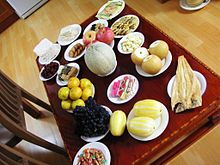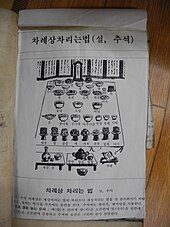Chuseok
| Korean spelling | |
|---|---|
| Korean alphabet : | 추석 or 한가위 |
| Hanja : | 秋夕 |
| Revised Romanization : | Chuseok or Hangawi |
| McCune-Reischauer : | Ch'usŏk or Han'gawi |
Chuseok ( Korean : 추석 or 한가위) is a traditional South Korean holiday. It is celebrated on the 15th day of the eighth lunar month and is one of the most important traditional festivals in South Korea , along with the Seollal New Year festival and the Dano festival. The name Chuseok means autumn evening . The festival is often called Hangawi ("great center").
The name comes from the fact that the festival takes place on a full moon night in the middle of the Chinese year. In South Korea, the Gregorian calendar is officially used, but the Chinese calendar , which is based on the lunar cycle, is used to calculate public holidays . So it happens that Chuseok is always celebrated at the time of the full moon.
In terms of meaning, Chuseok is initially the South Korean equivalent of Thanksgiving . For this reason, for the Chuseok festival in the house of the head of the family, large quantities of diverse dishes are served, which are eaten by the relatives who have traveled during the festival. The most important dish is songpyeon ( 송편 ), a green rice cake with sesame filling and a pine aroma.
The festival has been celebrated at least since the early days of the Silla dynasty ( 57 BC to 936 AD), when it originally emerged from a one-month web competition. The team that had woven more clothes for Hangawi was the winner and was given a party by the losing team.
During the festival, not only the honoring of the socially superior family members and the ancestors is carried out ( 차례 / 茶sondern ), but also all kinds of games are carried out in a fun atmosphere. In many families, many songs are sung and a lot of alcohol is drunk. An important part of the festival for the children and young people is the fixed deposit that they receive when they honor the older family members.
For most of the residents of Seoul , meeting the head of the family means leaving the city via Chuseok and traveling home to their parents, grandparents or the house of their eldest brother. Since all of South Korea is on the road these days, traffic chaos is an integral part of which a good 12 to 14 hours drive can be planned for a route that usually takes 4 hours. Avoiding country roads or leaving early in the morning does not bring any relief either, as many others are pursuing the same strategy. In 2010 the traffic situation was aggravated by the heaviest rainfall in September since the weather records began.
Even for those who stay at home and are waiting for the relatives, Chuseok is a strenuous festival, because after all they have to prepare all the dishes that are presented to the relatives and the ancestors. The Chuseok Party Service, which brings traditional dishes into the house for a fee, is therefore becoming increasingly popular . Then all that remains is the work of decorating and serving. Traditionally, members of the family wear a festive version of the Korean costume (Hanbok) at Chuseok .
Events
Chuseok and the day before and after are public holidays in South Korea. In the following years, the Chuseok evening is on the following days:
- 2013: September 19th
- 2014: September 8th
- 2015: September 27th
- 2016: September 16
- 2017: October 4th
- 2018: September 24th
- 2019: September 13th
- 2020: October 1st
- 2021: September 21
- 2022: September 10th
Individual evidence
- ^ Unusual weather seen in September. The Korea Times, September 24, 2010, accessed September 26, 2010 .
See also
Web links
- Article Insights into the modern Chuseok festival and Chuseok 2010 on the website of the South Korean tourism organization


